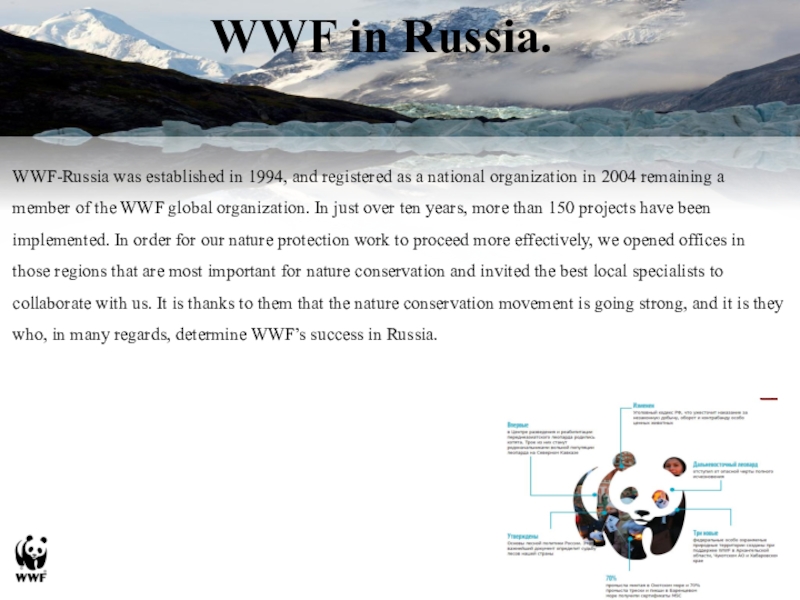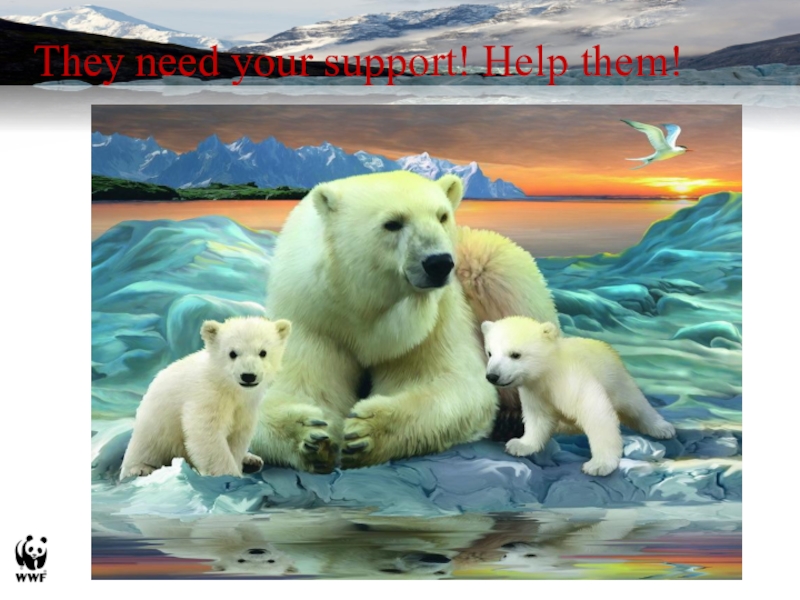- Главная
- Разное
- Образование
- Спорт
- Естествознание
- Природоведение
- Религиоведение
- Французский язык
- Черчение
- Английский язык
- Астрономия
- Алгебра
- Биология
- География
- Геометрия
- Детские презентации
- Информатика
- История
- Литература
- Математика
- Музыка
- МХК
- Немецкий язык
- ОБЖ
- Обществознание
- Окружающий мир
- Педагогика
- Русский язык
- Технология
- Физика
- Философия
- Химия
- Шаблоны, фоны, картинки для презентаций
- Экология
- Экономика
Презентация, доклад на Английском языке: WWF- World Wildlife Fund- организация защиты природы.
Содержание
- 1. Презентация на Английском языке: WWF- World Wildlife Fund- организация защиты природы.
- 2. The world is where we live!We are all connected!BECOME THE
- 3. Advertising!!! This polar bear wants its baby to be saved.
- 4. Our fragile world needs a strong defender.May be you will be this defender!!!
- 5. What is WWF? WWF, the global conservation
- 6. WWF in Russia.WWF-Russia was established in 1994,
- 7. SpeciesHabitat loss is the considered the greatest
- 8. The beneficial results of programs carried out
- 9. look in their eyes, they also want to live!!!
- 10. How can we protect the polar bear
- 11. .During the years that the project has
- 12. Bear patrolThe problems caused by global climate
- 13. A group of volunteers, unofficially known as
- 14. The polar bear is in danger!!!Now there
- 15. The global warming. According to scientists, the
- 16. Keep the house polar bears!Last fall, the
- 17. WWF explores the habitat of the polar
- 18. All this work is only possible thanks
- 19. You can help WWF's work in the
- 20. They need your support! Help them!
- 21. Thank you for your attention , take care of nature and its inhabitants!
Слайд 2The world is where we live!
We are all connected!
BECOME THE SUPPORTER OF WWF!
Everyone can
JOIN GOOD AND REALLY IMPORTANT AFAIR!
Слайд 5What is WWF?
WWF, the global conservation organization, is one of
WWF implements close to 2,000 projects annually in more than 100 countries around the world. Our main goal is saving nature while working with people. This is why representatives of indigenous peoples, business, other NGOs, government bodies, and, of course, our nearly 5 million members are among WWF’s many partners. Without them, our successes would not be possible.
Слайд 6WWF in Russia.
WWF-Russia was established in 1994, and registered as a
Слайд 7Species
Habitat loss is the considered the greatest threat to wildlife in
In conjunction with WWF, special ‘Leopard’, ‘Tiger’ and ‘Snow Leopard’ groups are developing new tactics and programs to combat poaching. WWF’s efforts resulted in the creation of strict nature reserves around habitats of rare species. WWF-Russia also created the first wild herd of European bison and reintroduced the species into the wild after uncontrollable poaching eliminated the species in the European part of Russia in the beginning of the 20th century. Since the implementation of WWF’s European Bison Conservation Program in the early 1990’s, the number of bison in the wild amounts to more than 100 individuals.
Слайд 8The beneficial results of programs carried out by WWF in collaboration
WWF efforts and activities would be impossible without its supporters. Thanks to the donation made by WWF supporter Andrey Kartashov, the Information and Education Center «Dom Leoparda» («Leopard s Home») was created on the border between Barsovy and Kedrovaya Pad nature reserves in the Far East. This is the first major project carried out on a personal donation made by a WWF-Russia supporter.
Слайд 10How can we protect the polar bear during this difficult period?
Polar bear
Слайд 11.
During the years that the project has been in existence, the
Слайд 12Bear patrol
The problems caused by global climate change, especially distinctly began
In 2006, with the support of WWF-Russia in one of the coastal Chukchi villages was formed by a group of volunteers, the initial goal was to patrol the surrounding area in October-December.
At this time, along the coast from North-West to South-East are the polar bears, the landing approaching from the North ice in the Eastern part of the East Siberian sea.
Attracted by the remains of walrus in the villages, polar bears inevitably attend and settlements.
Слайд 13A group of volunteers, unofficially known as "Bear patrol", warned the
Currently, this network includes 15 municipalities, 6 station 7 natural protected areas (reserves and resources reserves) from O. the island on the West Russian Arctic to the Bering Strait in the East.
Currently, the activity "Bear patrol includes:
Coastal monitoring with participation of the inhabitants of the Arctic coastal settlements of Russia, the staff of coastal weather stations, protected natural areas.
Anti-poaching activities.
Environmental education of the local population.
Слайд 14The polar bear is in danger!!!
Now there are 20-25 thousand polar
Poaching. The polar bears in the Russian Arctic prohibited by law from 1956 To 1973, the countries of the Arctic basin, signed the Agreement on the conservation of polar bears, which, after its ratification and entry into force (1976) became an international legal basis for the conservation, study and use of the species. However, the price of animals ' skins and other trophies of its production on the black market is very high. WWF Russia fully supports article 7 of the Agreement between the government of the Russian Federation and the Government of the United States from 16 October 2000 "ON the CONSERVATION AND management of the ALASKA-CHUKOTKA polar BEAR POPULATION" which States that "No provision of this Agreement does not entitle on polar bears for commercial purposes".
Слайд 15The global warming. According to scientists, the area of ice cover
The environmental pollution in the Arctic. The waters and coastal ecosystems are contaminated by pesticides, radionuclides, the products of combustion of fuel, heavy metals, fuels and lubricants, oil etc., the polar bear is a long-lived predator, so his body is exposed to high concentrations of many toxic substances anthropogenic.
Слайд 16Keep the house polar bears!
Last fall, the area and volume of
Now there are 20-25 thousand polar bears.
By 2050 the population of this species could be reduced by two-thirds! Climate change, poaching, pollution of the Arctic, these are the reasons why the life of polar bears is in danger.
WWF is doing everything to keep the white house bears clean, safe and large enough that they could live, hunt and breed offspring.
With the support of WWF were created "Bear patrol" - a special team of inspectors and volunteers who protect polar bears and cubs from poachers and prevent the collision of man and the polar bears, save the life of both.


























